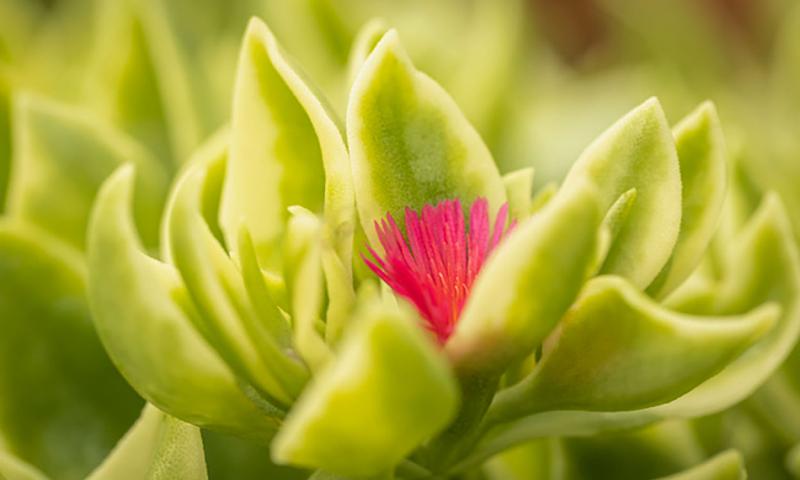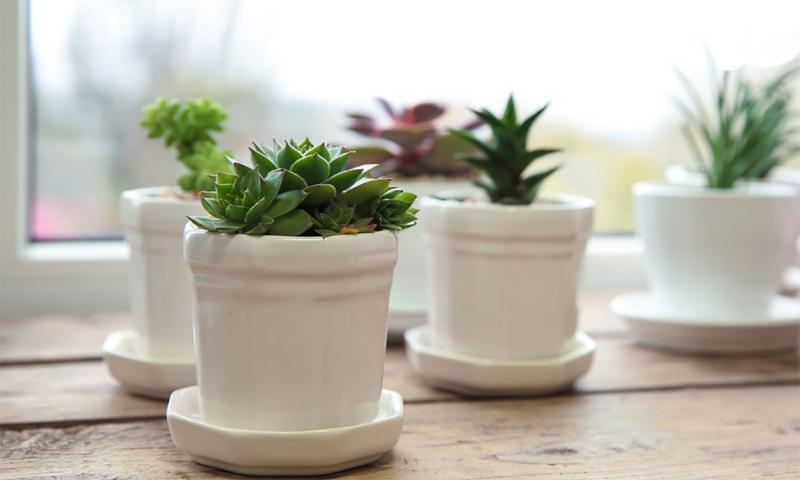
Written by Cindy Schnabel, South Dakota State University (SDSU) Extension Horticulture Assistant and Master Gardener, under the direction and review of Kristine Lang.
Succulents are native to every continent in the world, except the Antarctic. This group of plants is represented in over 40 botanical families. They come in a variety of sizes, shapes and colors.
The term “succulent” means “juicy.” Succulent plants have leaves and stems filled with stored water and nutrients that help the plant thrive in dry climates. The thick, often waxy, or leathery leaves provide protection against moisture loss. All these features allow the plant to withstand harsh conditions. These characteristics have made succulents very popular houseplants.
Caring for Succulents
Light
Most succulents thrive in bright, indirect sunlight. Southern or western exposure within your home will be a good location for most succulents, as they need at least six to eight hours of light. If you cannot achieve this, artificial light can make up for the lack of natural light. A good tip to remember is to rotate succulents frequently. Succulents tend to lean towards the sun or light source. Rotation will allow the plant to become stronger and grow straighter.
Potting Mix
To keep succulents happy, pay attention to the potting soil. Their preferred growing mix is one designed to drain better and stay drier than regular potting soil or garden soil. You can purchase pre-mixed cacti or succulent potting mixes from most garden centers. You can also make your own mix by using one-part potting soil to one-part coarse sand, pumice or perlite. This mimics the succulent’s natural environment and allows for the best drainage.
Fertilizer
Succulents need very little fertilizer and should only be fertilized in the spring and summer months when the plant is actively growing. A water-soluble fertilizer mixed at half the label rate can be used every three to four waterings during the growing season. Alternatively, you could use slow-release fertilizer granules once at the beginning of the spring.
Temperature
Many succulents grow naturally in climates that have high daytime temperatures. However, the plants are relatively flexible regarding their growing temperature, with the range of 60 degrees to 80 degrees Fahrenheit for most species.
Some succulents do better with cooler nighttime temperatures, and in some species cooler temperatures may trigger flowering.
Watering
Succulents hold water in the fleshy part of their leaves, making it easy to overwater them. When getting ready to water, test the soil with a finger to see if the soil is dry. If it feels dry, water the soil directly. Start by making sure the pot has a drainage hole, and you should notice water draining out the bottom. This will ensure it is thoroughly watered and that salt doesn’t build up.
A succulent can be watered once a week or less, depending upon how quickly the soil dries out in the pot. There is no need to water again until the soil is completely dry.
In spring and summer months, the plant will thrive. The need for water will increase. In the fall and winter months, which are months of slower growth as light levels decrease, the need for water declines. Overwatering of succulents is one of the most-common causes of death.
Common Problems
overwatering
The biggest mistake is overwatering, which can lead to the plant becoming mushy, turning yellow and dropping leaves. Overwatering can also lead to rotting roots from waterlogged potting soil. Sometimes the plant can be saved if allowed to dry out completely in-between future waterings.
Lack of Light
If your plants are looking long and lanky, consider moving them to a brighter location, as this stretching is a sign that there is not enough light in the current spot.
Mealy Bugs
Mealy bugs can make succulents their home and will show up as small, cottony masses in the joints of stems and leaves. Rinsing the foliage can remove some mealy bugs. Rubbing alcohol applied to mealy bugs as a light spray or dabbed with a cotton swab will also kill these insects.

Succulents are used to harsh environmental conditions. They are tolerant of neglect. The plants’ ability to grow in a variety of temperatures and infrequent watering requirements makes them easy to grow for the beginner and Master Gardener alike.
Additional Resource
Steil, A. 2021. ISU Extension. Care of Succulents Indoors.
Special thanks to SDSU Extension Master Gardener Tim Schreiner for serving as volunteer copyeditor of this article.


